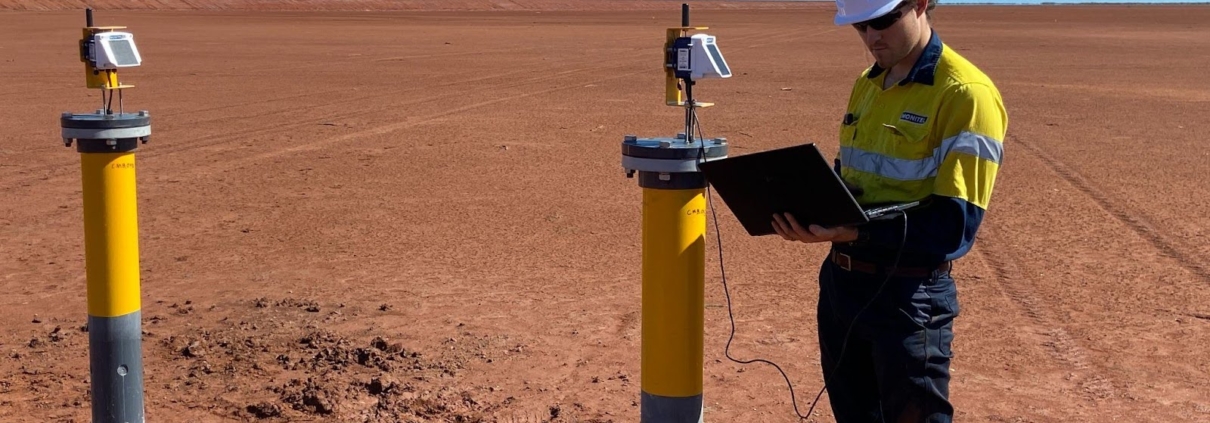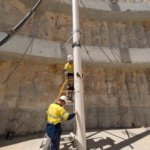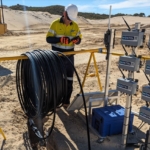Installation Techniques for Vibrating Wire Piezometers in Deep Boreholes
Installing a vibrating wire piezometer in a deep borehole requires careful planning, reliable instrumentation and a comprehensive methodology. With proper preparation, you set your self up for high-quality data with long-term reliability.
In Western Australia, extreme ground conditions and strict regulatory expectations are the norm, so precision in borehole installations is essential for effective monitoring.
Drawing on Monitel’s practical experience in WA industry, this guide outlines best-practice techniques for vibrating wire piezometer installation in deep boreholes.
What Is a Piezometer?
A piezometer is a geotechnical instrument used to measure pore water pressure in soil, rock or fill material. The vibrating wire piezometer is a subcategory of this sensor that converts pressure changes into frequency shifts in a tensioned wire. Those are then translated into pressure readings.
They have a rugged design, long-term stability and are resistant to electrical noise – making them ideal for deep installations and remote monitoring. That might include tailings dam surveillance, groundwater management projects or a broader regulatory compliance system.
Planning for Deep Borehole Installations
Before installation, project managers and engineers must define:
- Target monitoring depth(s)
- Expected groundwater and geotechnical conditions
- Borehole diameter and casing type
- Backfill requirements
- Data retrieval method
Our team can assist with site-specific assessments to determine the ideal installation plan. For deep boreholes, a vibrating wire piezometer is preferred for its signal integrity and compatibility with automation.
Step-by-Step Installation Method
1. Drill and Log the Borehole
Using the appropriate drilling technique, we advance the borehole to the required depth. Our team also collect data during this stage to verify stratigraphy and determine the placement of sensors.
2. Assemble the Sensor
Each vibrating wire piezometer is assembled with its cable, protective tubing and a porous filter tip. We ensure they are waterproofed and tested for signal integrity prior to deployment.
3. Position the Sensor at Depth
We lower the sensor to the target depth using a weighted guide or PVC pipe to prevent twisting and tangling. If multiple sensors are being installed in the same hole, we pre-plan a string with sensors at designated intervals.
4. Place Filter Sand
A graded silica sand is poured around the piezometer tip to ensure hydraulic connection with the surrounding soil or rock. It enhances the sensor’s ability to measure true pore pressure.
5. Seal the Zone
Our team isolate the measurement zone with a bentonite pellet or grout seal. This prevents vertical seepage and hydraulic short-circuiting, both of which distort readings.
6. Backfill the Borehole
The remainder of the borehole is filled with bentonite, cement grout or a mix of both. If multiple sensors are installed, we may alternate sand and bentonite seals.
7. Cable Protection and Surface Termination
Protected with conduit or casing, sensor cables are routed up the borehole. At the surface, they are terminated in the datalogger of your choosing. Our team will make sure all installations are secured and labelled for easy maintenance.
Considerations for Western Australian Conditions
In WA, deep boreholes are often located in remote, high-temperature and/or corrosive environments like:
- Mine pit walls in the Pilbara
- Tailings dams in Goldfields regions
- Transport corridors over reactive clay formations
These conditions are harsh and unforgiving, so it’s important to select a VWP with an appropriate cable length, pressure range and temperature tolerance. We also stock and install high-temperature vibrating wire piezometers for sites where geothermal gradients or buried infrastructure make standard hardware unviable.
When it comes to data acquisition, we design systems with WA’s telemetry limitations in mind. That includes automated, solar-powered and satellite-capable options where cellular coverage is poor or regular access is difficult.
Choose Monitel for Vibrating Wire Piezometer Installations?
There’s no single solution to installing a vibrating wire piezometer in a deep borehole. For a seamless, precise installation you need to consult geotechnical specialists and invest in reliable instrumentation.
That’s exactly what we deliver across Western Australia. With a tailored monitoring system and hands-on support, Monitel can help you assess subsurface conditions with confidence.
From installation to data interpretation, we take a technology agnostic approach that prioritises the needs of your site. We don’t choose the sensors convenient to us – we choose the sensors ideal for you.
If you’d like help designing or installing a VWP monitoring system for your site, contact the Monitel team today.




Leave a Reply
Want to join the discussion?Feel free to contribute!